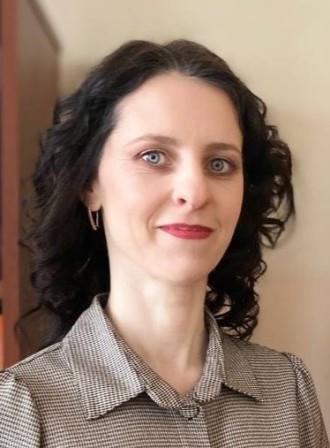Предполагается, что к концу учебного занятия учащиеся смогут рассказать на английском языке про географическое положение Республики Беларусь, ее национальные символы и природу по опорному конспекту с помощью гексов.
 Ольга БУЙКО,
Ольга БУЙКО,
учитель английского языка
ГУО «Средняя школа № 1 г. Фаниполя»,
Минская область
Тема: «Географическое положение Республики Беларусь».
Тип урока: урок совершенствования речевых навыков.
Вид урока: традиционный.
Формы работы: индивидуальная, групповая, коллективная.
Цель: предполагается, что к концу учебного занятия учащиеся смогут рассказать про географическое положение Республики Беларусь, ее национальные символы и природу по опорному конспекту с помощью гексов.
Задачи:
– создать условия для развития у учащихся познавательного интереса к родной стране, потребности расширять свой кругозор;
– способствовать активизации языкового материала в устной речи; формированию коммуникативной компетенции учащихся;
– содействовать развитию навыков говорения, умения формулировать мыли на иностранном языке.
Учебно-методическое обеспечение урока: учебное пособие для 6-го класса, наглядный и раздаточный материал, гексы, задания, созданные на онлайн-платформе LearningApps, презентация.
Оборудование: компьютер.
Ход урока
1 Организационно-мотивационный этап урока. Введение в атмосферу иноязычного общения
Good afternoon, my dear children! I’m glad to see you today.
How are you today? Are you ready to start?
I see that you are ready to start our lesson.
2 Определение темы и цели урока
Let’s guess what we are going to talk about.
On the board you see some pictures. Say what is it and name the first letter of it.
Bison, elk, lake, anthem, river, uniform, school (Belarus)

Иллюстрации можно скачать здесь.
And you see the topic of our lesson. We are going to speak about Belarus.
The aims of today’s lesson are:
To improve speaking skills (speak about nature, geographical position and symbols of our country, role play the dialogues)
To improve reading skills (read the texts about Belarus)
To revise grammar material (speak about numerals)
3 Фонетическая зарядка. Развитие навыков произношения
Let’s listen a short poem about Belarus, and be ready to read it as well. Pay attention to the pronunciation.
Belarus
The land of white storks
And the land of cornflowers,
The land of blue lakes
And long rivers as well,
The land that’s called
So nicely Radzima,
The land which I love
It’s my country and home!
Do you like this poem? What emotions do you have when you are reading the poem?
4 Проверка домашнего задания. Контроль усвоения лексического материала.
At home your task was to learn some new words. Look at the screen and find 10 words.
https://learningapps.org/watch?v=pdd3bswj323
Numerals: write them on the board.
2 миллиона людей, 10 тысяч животных, сотни птиц, миллионы людей, тысячи километров, 80 тысяч квадратных километров, 20 учеников.
5 Операционно-деятельностный этап. Развитие навыков чтения
Предтекстовый этап. Снятие лексических трудностей
Now we are going to read the text about Belarus. But first of all pay attention to some words from the text.
Poland
Lithuania
Ukraine
Russia
Eastern Europe
The Dnieper
The Neman
The Wester Dvina
The Pripyat
The Bug
200,000 sq km, 3,000 river, 4,000 lakes.
Текстовый этап. Чтение текста. Развитие навыков чтения
The official name of the country is the Republic of Belarus. Belarus is situated in Eastern Europe. It borders on Poland, Lithuania, Latvia, the Ukraine and Russia.
The area of Belarus is more than 200,000 sq.km. The population of the country is about 10 million people.
The capital of the republic is Minsk, which is also its largest city. Other large cities are Gomel, Brest, Vitebsk, Grodno and Mogilev.
The Republic of Belarus has its symbols: the anthem, the emblem, the flag and the costume. The national flag of Belarus is red, green and white, where green is a symbol of our green forests and red is a symbol of life and hope. Belarus is famous for its white storks. People say, they are a symbol of good luck. The white colour is the symbol of peace. The blouses and the shirts in Belarusian national costume are white with beautiful red ornaments – crosses and stripes.
Belarus is famous for its beautiful nature. One third of the republic’s territory is covered with forests. The largest of them are called pushchas. The most beautiful is the Belovezhskaya pushcha. The symbols of Belovezhskaya pushcha is the bison, a very strong animal.
The symbol of Belarusian fields is the cornflower – a small blue flower.
There are 3,000 rivers in the republic. The longest rivers are the Dnieper, the Neman, the Western Dvina, The Pripyat and the Bug. There are 4,000 lakes in Belarus. The largest of the lakes is the Naroch. People sometimes call Belarus the blue – eyed country.
Послетекстовый этап. Контроль понимания прочитанного текста
I Finish the sentences:
1. The official name of the country is … .
2. The population of the country is … .
3. The capital of the country is … .
4. The national flag of Belarus is …
5. Belarus is famous for its … .
6. The largest of forests are called … .
7. The longest rivers are… .
8. The largest of the lakes is … .
9. Also people call Belarus …. .
II Answer the questions.
1. What countries does Belarus border on?
2. What are the largest cities in our country?
3. What symbols of our country can you name?
4. What does the colours of national flag mean?
5. What do you know about national costumes?
6. What is the symbol of Belarusian fields?
6 Физкультминутка.
True\false sentences. If the sentence is true stand up. If the sentence is false raise your hands.
1. Belarus is situated in Africa. (False)
2. Belarus has six regions. (True)
3. We live in Minsk region. (True)
4. There are a lot of mountains in our country. (False)
5. There are a lot of lakes and rivers in Belarus (True)
6. The highest point is Dzerzhinskaya Gora. (True)
7. There is a big sea on the territory of Belarus. (False)
8. The official languages are Belarusian and English in Belarus. (False)
9. The capital of Belarus is Minsk. (True)
7 Операционно-деятельностный этап
Развитие навыков говорения
Работа в парах
Take the number and find your partner. You have two minutes to make up dialogues and role play it.
1. – Have you been to Belovezhskaya pushcha?
– Yes, I’ve been to Belovezhskaya pushcha.
– Have you seen a European bison there?
– Yes, I have. I’ve seen a European bison there.
– When did you go there?
– I went there last year. I loved it.
2. – Have you visited Nesvizh or Mir?
– Yes, I’ve visited Nesvizh and Mir.
– What was it like?
– I saw the famous castles and it was fantastic!
– Are you a well-travelled person?
– Yes, I am a well-travelled person.
3. – Hello
– Hi!
– Is this your first visit to Belarus?
– Yes, it is. It’s my first visit to Belarus.
– Do you like Belarus?
– Yes, I do, very much.
– DO you take pictures ( photos) of Belarus?
– Yes, I do. Belarus is so beautiful.
– Bye-bye!
– GooodBye!
4. – Have you visited Minsk?
– Yes, I’ve visited Minsk.
– Did you see the National Library?
– I saw this big building and it was fantastic!
– Did you like it?
– Yes, of course and I want to visit it once again.
Very well. Your answers were brilliant.
Let’s have one more task for today.
8 Развитие навыков говорения
Работа в группах
I see that you understand all the information about our country. I have a sweet presents for your good job. I have a basket with sweets. Let’s choose and take one.
Now pay attention to their colours. (colours of group). Take your seats.
You will work with hexes.
1. Geographical position of Belarus (orange sweets)
2. Belarusian nature (blue sweets)
3. Symbols of Belarus (green sweets)
I give you 7 minutes to make hexes, glue them on the paper and be ready to speak about your topics.
Let’s start to present your hexes.
Very well. Your answers were excellent.
9 Рефлексивный этап
Look at the screen. We have a quiz about Belarus. Let’s answer the questions (Рresentation).
Let’s sum up our lesson. Did you like the lesson?
10 Подведение итогов урока. Объяснение домашнего задания
At home your task will be to do ex. 3a, p. 64
Read the text, translate it and be ready to answer the questions. Open your record books and write down.
Today you worked hard and your marks are …
Thank you for the lesson, you may be free.




 Предложить публикацию
Предложить публикацию